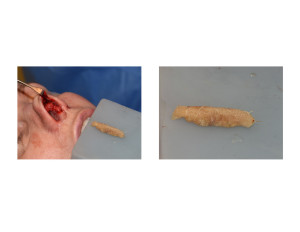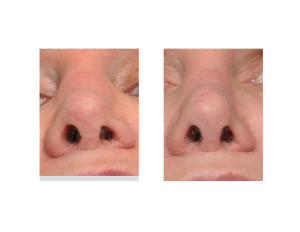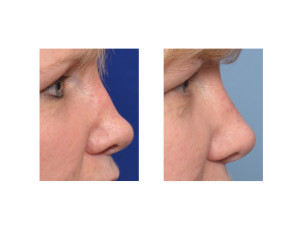Background: Depressions along the dorsal line or bridge of the nose can be caused by a wide variety of reasons. Trauma, congenital deformities and adverse outcomes from a prior rhinoplasty can create dorsal line irregularities and indentations. The use of cartilage grafts for their correction would be a standard approach.
Cartilage grafts can be obtained for either the septum, ear or rib donor sites. The septum is always the first choice because it is a straight piece of cartilage and can offer a fair amount of graft material. But this donor site is often depleted from prior harvesting. The ear is the second choice but it is not ideal for the dorsal line because it is curved graft with low volume. The rib provides an unlimited amount of cartilage but leaves a subcostal scar from its harvest and is prone to warping and edge visibility.
The shape inadequacies of rib cartilage can be gotten around by using a technique known as ‘diced cartilage grafting’. In this technique the rib cartilage is cut into small pieces and placed in a variety of containment wraps. Once the particulated cartilage graft is placed, it can be digitally molded into the desired dorsal line shape.
Case Study: This 45 year-old female had a rhinoplasty done several years before which left her with multiple aesthetic nasal shape concerns. Most prominently there was a depression from the tip backwards up to the middle portion of the dorsum. The left nostril and nostril rim was also collapsed and she had trouble breathing in and out of the left nostril.


Rib grafts to the nose provide all the volume any rhinoplasty procedure would need, particularly for dorsal augmentation. Its main disadvantage of graft warping can be eliminated by the creating a diced cartilage graft. Different surgeons use containment wraps from surgical mesh, fascia and thin allogeneic dermis. I have used all of these diced rib graft rhinoplasty methods but have not seen any major differences in outcomes between them.
Highlights:
1) Dorsal depressions of the nose can be treated by a variety of materials and cartilage grafts.
2) Larger dorsal deformities with other nasal reconstructive needs requires a bigger cartilage graft than one may think.
3) A diced rib graft rhinoplasty provides both ample augmentation volume and avoids any risks of warping or graft irregularities.
Dr. Barry Eppley
Indianapolis, Indiana



